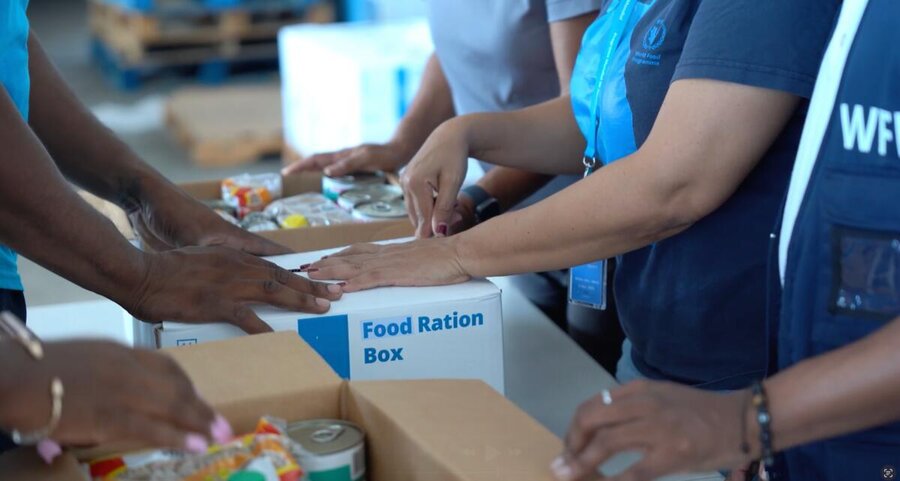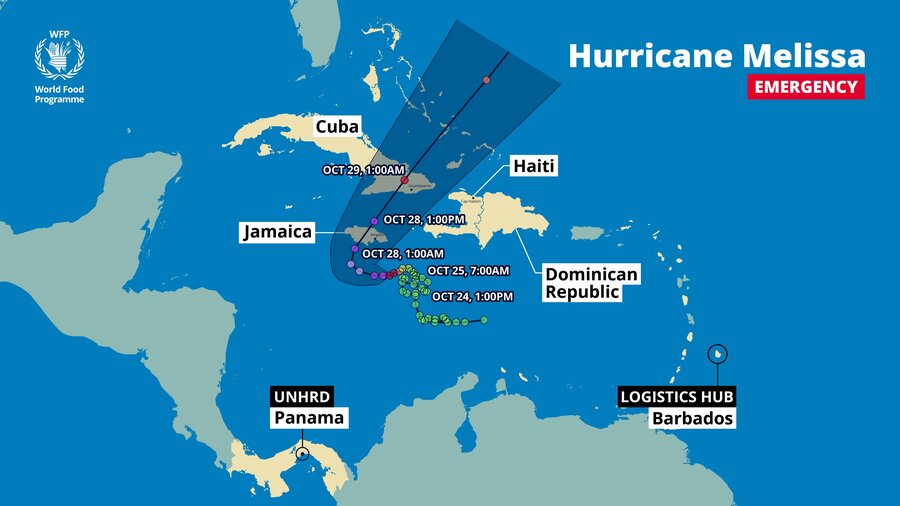Hurricane Melissa: WFP at hand as Jamaica responds to its ‘worst storm ever’
The World Food Programme (WFP) is working around the clock to support the Government of Jamaica as the island nation faces “one of the worst disasters in its history.”
Hurricane Melissa is closing in on Jamaica with wind speeds exceeding 150 miles per hour at Category 5 – the most vigorous intensity – with widespread destruction expected at the centre, said Brian Bogart, who leads WFP’s Caribbean Multi-Country Office in Barbados.
Bogart, who has travelled to Kingston, added: “The eye of the storm is projected to hit west of the island, but [the right quadrant of its] northern side – typically the most destructive – will still cause widespread damage.”
DONATE: Support WFP's Hurricane Melissa Response
Jamaica’s mountainous terrain increases the risk of flash floods, major landslides, and infrastructure damage. Storm-surge projections range from 9ft to 13ft, threatening low-lying coastal communities and potentially impacting Kingston, with 12 hours of rainfall destruction expected.
The south coast is expected to be hardest hit. “This kind of [hurricane] surge is almost like a tsunami, wiping out infrastructure and making access extremely difficult.
“Access will be a major challenge. If the storm surge hits hard, it will be difficult to get humanitarian staff in and move food and relief supplies – alternative airstrips are being prepared."

Prepositioning is key. Four mobile warehouses are already in place, with more on the way, along with generators and other logistics assets to enable a rapid response.
WFP is initially airlifting 2,000 emergency food kits from the eastern Caribbean island of Barbados, “enough to assist around 6,000 people for ten days”.
Bogart said: “When we have a whole country affected by disaster, there’s no staging area – no area that's unaffected that you can respond from, so you need to be able to stand up your response from outside the country in certain cases. And each island is different”.
Amid this “uniquely challenging geography”, WFP looks to support Government responses through sea and air transport, moving in supplies from outside.
With infrastructure at risk of being overwhelmed, the private sector “will be knocked back, disrupting food supplies” Bogart added. “Then it's not only a question of people being impacted and not having access to food, but also how quickly and how resilient that food system is to uphold food supplies post-impact.”
Humanitarian supplies
“Through our partners in the ETC (Emergency Telecommunications Cluster), we can help to provide power and access to internet in the municipal councils and parish government level so that the local government also can function, has access to internet and telecommunications while the private sector supports the mobile networks.”
WFP is also scaling up disaster financing across the Caribbean region so that people have access to insurance payouts and have the means to buy essentials in the wake of a disaster.
Emergency preparedness efforts include digitizing data collection, warehouse management and prepositioning logistics assets such as mobile warehouses, generators, chainsaws and satellite-based units for connectivity. “These are being dispatched to areas of the country that are mostly likely to be affected to enable rapid response.”
Since Jamaica imports much of its food, recovery will depend on how quickly supply chains can be restored, said Bogart.

Working with partners, including in the commercial aviation sector, “coordination is ongoing with the International Organization for Migration, UNICEF and others to move humanitarian supplies by air and sea,” said Bogart of stocks prepositioned by the Caribbean Regional Logistics Hub in Barbados – launched in May and led jointly by WFP and the Caribbean Disaster Emergency Management Agency (CDEMA).
As the key liaison, the CDEMA enables swift action during emergencies. WFP supports governments in shifting essential items, such as tents, hygiene kits and medical supplies.
Melissa is the biggest hurricane to hit the Caribbean since Hurricane Beryl in July last year, and the strongest storm seen anywhere in the world this year.
“Beryl affected three countries, each requiring separate operations with skeleton staff,” said Bogart. “Jamaica, being a much larger country [than Saint Vincent and the Grenadines, which bore the brunt of Beryl], will see a significantly higher number of people affected. This will test the model.”
He explains: “Governments lead the response, but with Melissa, the scale of disaster and the partner response could overwhelm them. WFP support includes deploying experienced personnel to help set up coordination mechanisms.”
National NGOs
In Jamaica, WFP works closely with ODPEM (the Office of Disaster Preparedness and Emergency Management) and the Ministry of Labour and Social Services, focusing initially on people in shelters whose food supplies will run out quickly. “Partnerships with national NGOs like Food for the Poor, which has parish-wide reach through church networks, are key to localizing the response,” said Bogart.
Cuba, the Dominican Republic and Haiti are also braced for Melissa's impact.
WFP’s multi-country office model serving Caribbean islands means “small teams provide technical assistance across ten countries,” said Bogart. Except for Haiti, Cuba and the Dominican Republic, “there are no full country offices – only liaison and technical staff – so when disaster strikes, surge capacity is essential.”
Bogart added: “Unlike continental disasters, islands face unique challenges ... I think we need to be able to look at providing support to the overall food supply in collaboration with the private sector to provide assistance where necessary. We also need to look at how we can help support the logistics infrastructure that will be required for enabling the support.
“That would require not only funding, but also critical partnerships in support of governments and the private sector to get Jamaica up and running again as quickly as possible after impact.”
WFP’s preparedness actions in the Caribbean
In Haiti, heavy rainfall is expected to lead to flooding and road closures in the south-west of the country. The Haitian government and WFP have sent more than 3.5 million text messages to provide practical guidance on how to prepare, stay safe, and reduce injuries and damage to homes and assets.
To further support communities, WFP is providing anticipatory e-money distributions to meet urgent humanitarian needs and help people protect their livelihoods ahead of the storm. The distributions will reach approximately 45,000 people and total US$900,000.
In Jamaica, WFP is on the ground, coordinating with the government and the Caribbean Disaster Emergency Management Agency, to support with emergency logistics and telecommunications, supply chain, and food and cash assistance as required. WFP has also partnered with the government and the Caribbean Catastrophe Risk Insurance Facility, a sovereign insurance mechanism, to enable access to quick financial liquidity for vulnerable impacted households via national social protection systems, should the tropical cyclone policy for wind speed trigger.
In Cuba’s eastern region, which is most at risk, WFP and the government have prepositioned food supplies to support 275,000 people for up to 60 days. This will ensure an immediate response to potential disruptions caused by the storm.
In the Dominican Republic, more than 4,000 vulnerable households in flood-prone areas will receive cash to prepare for the storm and reduce the impact on household food security. If needed, emergency food assistance will be activated in the southwestern provinces to reach up to 6,000 families with ready-to-eat meals for five days and dry rations for 15 days.
At the government’s request, WFP is supporting response planning through the Automated Analysis System for weather events and Operational Alerts platform, strengthening evidence-based preparedness and coordination.
On a regional level, the WFP Caribbean Regional Logistics Hub in Barbados has more than 500 pallets of relief supplies and logistics assets from partner organizations prepositioned for air and sea deployment to affected countries. The most urgent items can be airlifted, while additional supplies are ready for maritime transport.
Additionally, the WFP-managed United Nations Humanitarian Response Depot (UNHRD) in Panama stands ready to deploy its Field Emergency Team and dispatch over 2,000 pallets of life-saving supplies – covering shelter, health, WASH, and logistics – from WFP’s corporate stocks and 16 humanitarian partners.
WFP’s preparedness and anticipatory actions efforts across the Caribbean are supported by the UN Central Emergency Response Fund (CERF), the European Civil Protection and Humanitarian Aid Operations (ECHO), the United States, Canada and Ireland among others.
